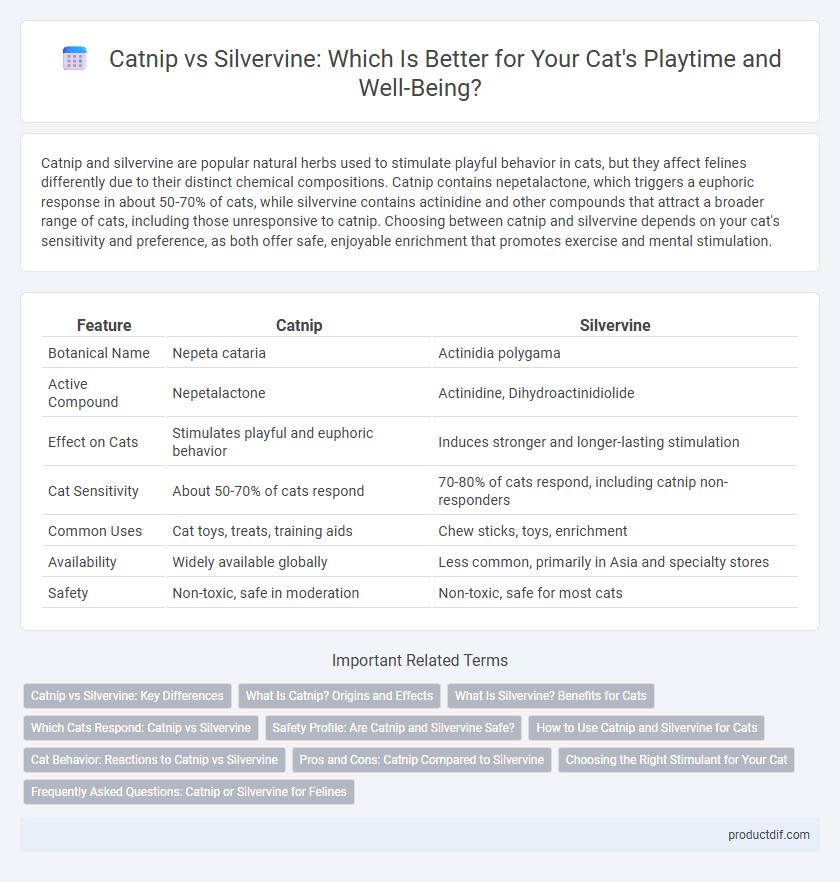Catnip and silvervine are popular natural herbs used to stimulate playful behavior in cats, but they affect felines differently due to their distinct chemical compositions. Catnip contains nepetalactone, which triggers a euphoric response in about 50-70% of cats, while silvervine contains actinidine and other compounds that attract a broader range of cats, including those unresponsive to catnip. Choosing between catnip and silvervine depends on your cat's sensitivity and preference, as both offer safe, enjoyable enrichment that promotes exercise and mental stimulation.
Table of Comparison
| Feature | Catnip | Silvervine |
|---|---|---|
| Botanical Name | Nepeta cataria | Actinidia polygama |
| Active Compound | Nepetalactone | Actinidine, Dihydroactinidiolide |
| Effect on Cats | Stimulates playful and euphoric behavior | Induces stronger and longer-lasting stimulation |
| Cat Sensitivity | About 50-70% of cats respond | 70-80% of cats respond, including catnip non-responders |
| Common Uses | Cat toys, treats, training aids | Chew sticks, toys, enrichment |
| Availability | Widely available globally | Less common, primarily in Asia and specialty stores |
| Safety | Non-toxic, safe in moderation | Non-toxic, safe for most cats |
Catnip vs Silvervine: Key Differences
Catnip contains the active compound nepetalactone, which primarily stimulates cats' olfactory receptors, causing behaviors like rolling and purring, while silvervine offers two active compounds, actinidine and dihydroactinidiolide, that can attract cats who are unresponsive to catnip. Silvervine also provides additional benefits, such as mild analgesic properties and possible immune support, making it a versatile alternative. Both catnip and silvervine vary in potency and effects depending on the cat's sensitivity and genetic factors, with silvervine often preferred for its stronger and longer-lasting stimulation.
What Is Catnip? Origins and Effects
Catnip (Nepeta cataria) is a herb from the mint family native to Europe and Asia, widely known for its euphoric effects on cats due to the active compound nepetalactone. When cats inhale catnip, it stimulates sensory neurons, triggering playful behaviors and temporary euphoria lasting around 10 to 15 minutes. Catnip is commonly used in pet toys and treats to encourage exercise and reduce anxiety in domestic cats.
What Is Silvervine? Benefits for Cats
Silvervine, a natural plant native to Asia, contains compounds that induce euphoria and playfulness in cats, similar to catnip but often with a stronger effect. It offers benefits such as enhanced mental stimulation, reduced stress, and increased physical activity, making it an excellent choice for indoor cats. Unlike catnip, silvervine also contains actinidine and dihydroactinidiolide, which can attract a wider variety of cats, including those unresponsive to catnip.
Which Cats Respond: Catnip vs Silvervine
Cats' responses to catnip and silvervine vary based on genetics, with approximately 50-70% of cats reacting to catnip through behaviors like rolling and purring, while nearly 80-90% show sensitivity to silvervine, including cats that are indifferent to catnip. Catnip contains nepetalactone, which stimulates cats' olfactory receptors, whereas silvervine contains actinidine and dihydroactinidiolide, triggering a broader range of feline responses. Silvervine is often considered a more potent alternative for cats unresponsive to catnip, making it a preferred choice for pet owners seeking diversity in feline enrichment.
Safety Profile: Are Catnip and Silvervine Safe?
Catnip and silvervine are generally safe for cats when given in moderation, with minimal risk of toxicity or adverse effects. Catnip contains nepetalactone, which triggers mild euphoria without harmful substances, while silvervine contains actinidine and other compounds that may appeal even to cats unresponsive to catnip. However, overconsumption of either can lead to mild gastrointestinal upset or overstimulation, so monitoring usage is essential for maintaining feline health.
How to Use Catnip and Silvervine for Cats
Catnip should be offered in small amounts, typically as loose dried leaves or inside interactive toys, to encourage playful behavior without overstimulation. Silvervine can be used either as dried sticks for cats to chew or in powdered form sprinkled on scratching posts and bedding to attract and engage more sensitive felines. Both substances should be introduced gradually to observe individual cat reactions and prevent potential digestive upset.
Cat Behavior: Reactions to Catnip vs Silvervine
Catnip triggers a euphoric response in about 70% to 80% of cats due to the nepetalactone compound binding to their olfactory receptors, resulting in behaviors like rolling, pawing, and vocalizing. Silvervine induces a similar but often stronger reaction because it contains both actinidine and dihydroactinidiolide, attracting cats that are insensitive to catnip. Cats typically display increased playfulness, rubbing, and licking with silvervine, highlighting its appeal for feline enrichment and stimulation.
Pros and Cons: Catnip Compared to Silvervine
Catnip attracts about 50-75% of cats due to the nepetalactone compound, providing stimulating and euphoric effects, but its appeal diminishes with repeated exposure. Silvervine contains actinidine and dihydroactinidiolide, which can stimulate up to 80% of cats, including some unresponsive to catnip, offering a broader range of stimulation options. While catnip is widely available and cheaper, silvervine may cause more intense reactions but can be harder to source and more expensive.
Choosing the Right Stimulant for Your Cat
Catnip and silvervine are popular natural stimulants that trigger euphoric reactions in cats, but their effects vary based on feline genetics and preferences. Silvervine contains actinidine and dihydroactinidiolide, compounds that often elicit stronger responses in cats unresponsive to catnip's nepetalactone. Selecting the right stimulant involves observing your cat's unique reaction patterns to each, ensuring safe quantities, and considering factors like potency and availability to maximize enrichment and play.
Frequently Asked Questions: Catnip or Silvervine for Felines
Catnip and silvervine are popular plants that elicit euphoric responses in many cats, but silvervine tends to be effective for a larger percentage of felines, especially those unresponsive to catnip. Silvervine contains two active compounds, actinidine and dihydroactinidiolide, which stimulate cats' sensory receptors differently than catnip's nepetalactone. Both can be used as safe enrichment tools for cats, but individual preferences vary, so offering both may help determine which induces the most playful and relaxed behavior in your feline.
Catnip vs Silvervine Infographic

 productdif.com
productdif.com